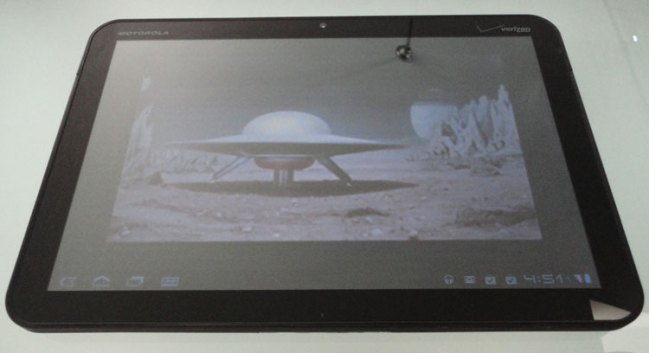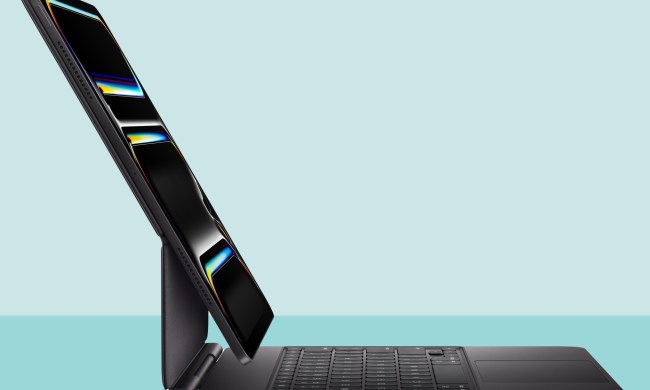
The Motorola Xoom is the first product to market using Android Honeycomb. The Xoom is attractive, and the screen is gorgeous, but I’m increasingly convinced that the only way to beat the iPad is with something truly unique.
People just rave about the iPad, and I don’t think they will do that about the Xoom, mainly because Motorola left it unfinished from the get-go.
Xoom’s competance
Generally, folks have about five things they like to do with tablets. These include browsing the Web, enjoying media (books, music, movies), e-mail, taking notes, and playing games.
The Xoom has a good browser but unfortunately the one advantage it was expected to have, Flash support, won’t be available until June – what a dumb move. Internet speed is not better than the iPad out of the gate either because the other advantage, 4G wireless support, isn’t available yet at this time too. It too should be an upgrade you’ll get in June, or about the time the new 4G iPad is supposed to show up.
The Kindle application loaded and ran nicely on the Xoom although I still prefer my Kindle to either the iPad or Xoom if given the choice, and can hardly wait for the first tablet with a transflective display. Slacker, my favorite music streaming service, loaded flawlessly, and the sound out of the Xoom’s built-in speaker was much better than that of the iPad. The Netflix client isn’t supported on Android, so Xoom shares the inability to run it with all other Android devices.
Moving movies onto the device wasn’t particularly easy either. There is no iTunes-like desktop client, and while it seemed to work with Windows Media Player, the movies didn’t actually seem to move until I copied them manually. Then I had to scan the device to see where to put them. I used already transcoded (MPEG-4) movies, and then watched Army of Darkness as a test.
The optional base, which came with the Xoom, has a nice set of speakers in it for a desktop experience and the clock application makes for an attractive desktop clock, but it plays ringtones for an alarm and you’d have to get another app to turn it into a full blown clock radio.
The Xoom supports Gmail out of the box, but you have to load a third-party application to do Exchange support. I’ve used a couple on other Android phones, and they are adequate. I’d prefer having this out of the box though. The best keyboards for the iPad typically come with a case for the device and allow you to prop the device up while using it in this mode. The Motorola keyboard doesn’t come with any way to hold the Xoom up, otherwise it worked fine and was easy to set up and type with.
I loaded Angry Birds and lost about an hour playing. Very addictive game.
Finally, the camera on the Xoom is one of the best I’ve yet used on a mobile device with a nice dual-LED flash.
Where’s the magic?
Part of what makes the iPad wonderful is the out-of-box experience. It pretty much comes with all of the initial stuff you need, and you don’t have to read a manual to figure it out. The Xoom felt somewhat unfinished in comparison – particularly when it came to playing videos. It took me far longer than it should have to get the experience I wanted. Once I got the video playing, the sound and picture were better than the iPad, but many people wouldn’t have spent the time, and likely given up frustrated. With the iPad, you get the sense that the Apple folks actually used the device – what a novel thought righ? With the Xoom, it feels like that final step may have never actually occurred. This isn’t a hardware or software problem as the device could do what I wanted, except for Netflix. It’s a usability issue, and this is where Apple continues to shine.
More than that, when Apple brings out a product, it presents it in a way that makes it hard to not get excited about. Motorola presented the Xoom to me in a room of five PR people, many of which were doing e-mail on their phones and not really engaged with the Xoom in the first place. Not a single one, except the guy doing the demo, was actually using a Xoom. It gave the impression they were presenting something they wouldn’t actually use themselves and it really took the excitement out of the device.

The accessory keyboard suggested you’d need a kickstand for the Xoom to make it work. The iPad has the same problem, but it also has third-party keyboards that come with stands and nicely integrate with the product. I felt that Motorola simply didn’t watch the iPad in use and instead is learning the hard way.
In the end, given the choice between an iPad and a Xoom I’d likely pick the iPad as something to give as a gift. For myself, I might pick Xoom, but would likely hold off until Flash support and LTE arrived. Against the iPad 2, I’d have a vastly tougher choice. If Motorola and Google improved the user experience and figured out how to get Netflix onto the device, I still might prefer it over the iPad 2, but it would be a tough call.
The magic is in the presentation
Tablets like the iPad and Xoom are far from cheap, generally costing close to $800 before any connectivity charges. People don’t want to become technicians in order to use them, and the Xoom has the feel of an incomplete offering. From the lack of Flash and LTE 4G support, to the difficulty in playing videos and the keyboard accessory without a kickstand, Motorola has a way to go. The Xoom has the bones of a great product but it needs to be fleshed out to be successful. That seems a shame because with a little more work, this probably would have been a truly great product. Apple products have a magic about them, and for anyone wishing to compete with Apple, baking in some polish in both the user experience and the presentation is a requirement that shouldn’t be overlooked.
Also take a look at our impressions of the Xoom from CES.



